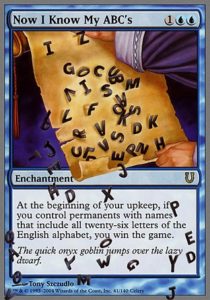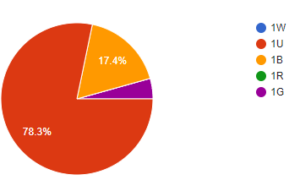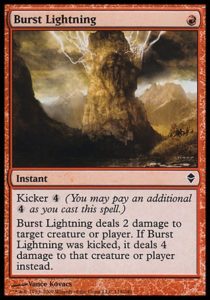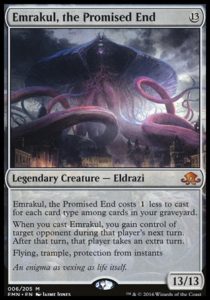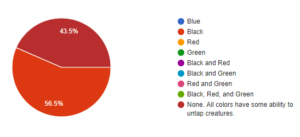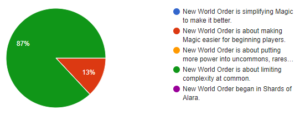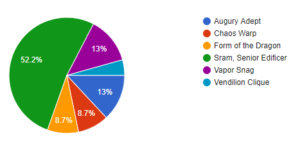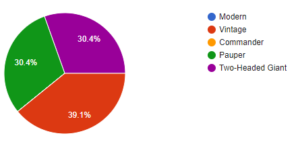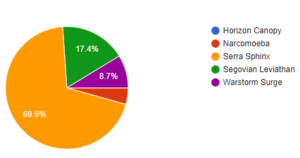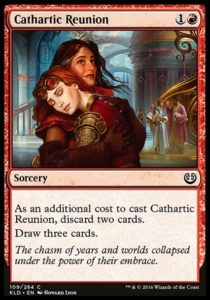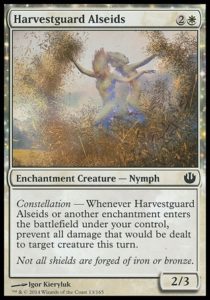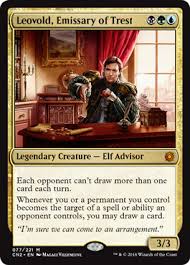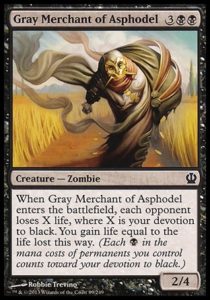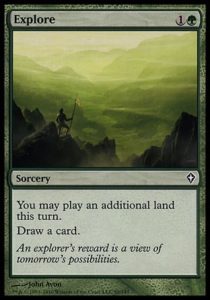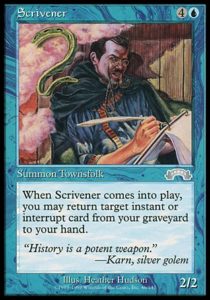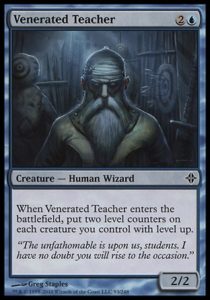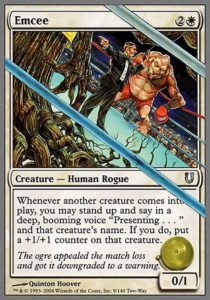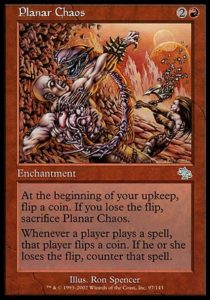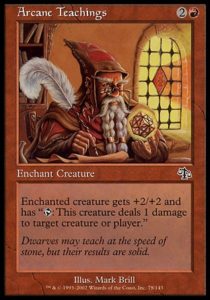By the time you finish reading this article (assuming you start right as it’s published), the third Great Designer Search will have begun. Until then, let’s go over all of last week’s challenges and critique some essays, for good measure.
Oh, and welcome to the FINAL Great Designer Training!
Callback Assignment: GDS2 Question 16
16) Which mana cost is least appropriate for this card?
Mimsy Borogove
Creature – Human
2/2
a) 

b) 
 – correct
– correct
c) 

d) 

e) 

In 2010, this was a thorny question because only green and white got bears at common (though every creature could get rare 2/2s for MM). The correct answer was blue because it didn’t get 2/2s for 2 even with down downsides (whereas black and red did). Today, red has Falkenrath Reaver and black has Walking Corpse, leaving blue bearless. I wouldn’t be surprised if blue breaks the bear barrier (bearier?) at some point.
I wanted to revisit question for the final week to get folks thinking about how things have changed in the past seven years. I think there’s some merit to green or white being the correct answer in the future. We’ve seen a steady increase in the power level of common creatures, and both white and green get bears with upside regularly.
Research Assignment: Recurring Template
There are several staple designs we see in Magic, touchstones that are revisited over and over again. The most well-known is probably Shock, which is powered up by a set-specific mechanic to do four damage. More recently, we’ve seen many Cancels with upside.
For this final assignment, find five different instances of recurring templates. For something to satisfy the (broad) definition of a template, you should have at least three examples for each template (since three is kind of the minimum necessary for a full pattern).
I focus on common removal spells a ton in this column, so I’m constantly comparing all of the twists on Tomb Hex, Disperse, Rage of Purphoros, Bound in Silence, and Giant Growth. I realize I was heavily focused on cards with the same color and coverted mana cost, and so focused less on all the blue card-filtering spells, Plummet variants, and fogs that users submitted.
There were a ton of good responses to this question, as I’ve been fortunate to receive each week. Researching and evaluating the recent past and mechanical color pie is an essential skill as a designer; you need to know what’s been done to provide a foundation for future designs to both buck and follow convention.
GDS-esque Questions
Question #1: Which color (or colors) is completely unable to untap creatures?
a) Blue
b) Black
c) Red
d) Green
e) Black and Red
f) Black and Green
g) Red and Green
h) Black, Red, and Green
i) None. All colors have some ability to untap creatures.
Oh, well then. This question was more deceptive than I meant for it to be and I think it could have been worded a bit better. Black does have creatures that untap themselves, like Scrib Nibblers, Helldozer, and Cinderhaze Witch. These aren’t commonly seen, but they do create a precedent. However, the last time black was able to untap something other than itself was Ice Age’s Norrit, which is completely out of color pie. I stand by my initial answer (which I’ll now explain), but I give everyone full credit for a question that I should have worded more clearly.
Blue and green are primary at untapping creatures and white is secondary at it. According to the mechanical color pie, that’s it. However, red is able to untap creatures by creating extra combat steps. This was a tricky question that rewarded you for not just looking up one answer on the Mechanical Color Pie, but also doing some research.
Question #2: Which is the most accurate statement about NWO (New World Order)?
a) New World Order is simplifying Magic to make it better.
b) New World Order is about making Magic easier for beginning players.
c) New World Order is about putting more power into uncommons, rares, and mythics.
d) New World Order is about limiting complexity at common.
e) New World Order began in Shards of Alara.
New World Order is often misunderstood to be many things. D is the repeatedly stated aim of it. B is a component of New World Order, but not the core of what it is. C has nothing to do with NWO (which is about complexity, not power level). A is an opinion, not a fact. E is incorrect; New World Order began in Zendikar, but some of its principles were applied in Alara Reborn.
Question #3: Which of the following cards is not a color pie bend or break?
a) Augury Adept
b) Chaos Warp
c) Form of the Dragon
d) Sram, Senior Edificer
e) Vapor Snag
f) Vendilion Clique
That’s quite the split among folks answers. All of these colors violate or violated something about the color pie, making this a tricky question.
Augury Adept is a color pie break. It gives white easy card advantage, undercutting one of its biggest weaknesses. It also gives blue life gain, something it doesn’t get (and which kind of undercuts the weakness of its slow speed). Shadowmoor and Eventide dipped so deeply into hybrid mana that they undermined the color pie.
Chaos Warp is one of the most egregious color pie breaks of the past decade. It undermines one of red’s biggest weaknesses, enchantments, a massive color pie break.
Form of the Dragon is a flavor win but is acknowledged to be bending the color pie. It takes the Island Sanctuary ability from white and blue. This doesn’t really undercut a red weakness, since red has been hating on ground creatures since Alpha’s Earthquake, but it’s still giving red something that’s not in its color pie.
Vapor Snag is a color bleed. Life loss is the exclusive territory of black, but New Phyrexia made everything feel mean and bleed a little black.
Vendilion Clique is effectively a discard spell, which is the purview of black. Yes, it’s a lot like targeting looting (which blue gets), but blue has never gotten this precise effect before and only gotten discard in Innistrad, New Phyrexia, and Planar Chaos. This is somewhere between a color bleed and a break.
The correct answer is Sram, Senior Edificer, but if you’d asked me a year ago, I’d have said that he’s a color pie break just like Mentor of the Meek and Puresteel Paladin. Sram’s printing coincided with R&D changing the color pie to allow white to get card advantage engines that require major deckbuilding concessions.
Question #4: Which format does R&D not consider when designing sets?
a) Modern
b) Vintage
c) Commander
d) Pauper
e) Two-Headed Giant
R&D generally only considers three formats when developing sets: Standard, Sealed, and Draft. However, we’ve seen a shift in design philosophy to include more cards for Commander players in expansions. So, we don’t get to eliminate the other three incorrect answers easily.
You can get to the correct answer in three ways. Either you’re aware of certain designs that did consider certain formats, you’ve followed certain Blogatog requests that consistently get a no from MaRo, or you’ve determined which of these formats Wizards basically can never design for.
Two-Headed Giant is the next easiest answer to eliminate. I don’t think R&D tests it much, if at all, but they’ve changed their templating on draining cards to improve the format. After the original Commander precons came out, we saw more cards like Syndic of Tithes and Gray Merchant of Asphodel whose effectiveness quadrupled in 2HG. This proved overpowered in the format and we now see cards that tend to drain fixed amounts of life, like Night Market Lookout. These cards work better in 2HG, but aren’t quite as oppressive.
R&D specifically doesn’t design for nonrotating formats and relies on banned (and restricted) lists to curate Modern, Legacy, and Vintage. However, we’ve seen them consider the health of the format when printing cards like Abrupt Decay (to beat Counterbalance), or print cards directly for it in Flusterstorm and True-Name Nemesis. We’ve moreover seen them at least ponder the effects of new designs on nonrotating formats in M-Files commentary. We’re also seeing Play Design focus more on nonrotating formats, particularly with the hiring of Tom Ross. We can eliminate Modern as a correct answer, since WotC has even less incentive and ability to design with Vintage in mind than they do Modern.
Pauper is the correct answer because while WotC cares a ton about what cards are printed at common, they will not and cannot downshift a card to common purely to make it legal in Pauper. Time and again people ask Mark Rosewater if an effect (like a wrath) can be made common to make it legal in Pauper, and MaRo responds that they’re essentially misunderstanding the format: to play Pauper is to adhere to an additional restriction. While certain effects are grandfathered into the format due to previous mistakes (like Pestilence being a common), Magic does not violate modern design principles to modify the format. This could somehow change if Pauper follows the path of Commander, but we haven’t gotten there yet.
Question #5: Vorthos question! Which of these cards is set on a plane which Magic has visited in a (non-core) expansion?
a) Horizon Canopy
b) Narcomboeba
c) Serra Sphinx
d) Segovian Leviathan
e) Warstorm Surge
Horizon Canopy represents Pyrulea, as seen on Horizon Boughs. Narcomoeba is from Iquatana, from The Aether Flues. Segovian Leviathan is from Segovia, home of The Hippodrome. Warstorm Surge represents the Immerstrum of Valla. Serra Sphinx is from Serra’s Realm, which was visited in Urza’s block. It’s from a colorshifted version of Serra’s Realm (which we’ve never seen), but it is from a plane which Magic has visited in a non-core expansion.
Design Challenge 1: Romantic Love
Red is the color of emotion and passion, but we rarely see it depict emotions other than anger. Design a card that communicates the concept of healthy, consensual, romantic love.
Star-Crossed Lover by lpaulsen
2R
Creature- Human (Rare)
3/3
When Star-Crossed Lover enters the battlefield, choose a creature an opponent controls.
Prevent all damage Star-Crossed Lover and the chosen creature would deal to each other.
Whenever a source would deal damage to Star-Crossed Lover or the chosen creature, it deals that much damage to each of them instead.
Oh, my. This is perfect. I love how resonant a trope this goes for and how well it hits. Fantastic work, lpaulsen!
Passionate Proposal by Martin Gallogly
3R
Sorcery
As an additional cost to cast Passionate Proposal, tap an untapped creature you control. Exile the top X cards of your library, where X is the tapped creature’s power. You may cast a creature card exiled this way without paying its mana cost.
This doesn’t hit the emotion on the head for me—it feels like a lonely creature crying out for someone, anyone else. That said, I like where this design went. It’s developmentally dangerous, but it’s nowhere near the level of Aetherworks Marvel and we’re designers, not developers. This is a very nifty engine card.
Flirt by David Backer
R
Common
Instant
Target creature you control can’t attack until end of turn.
Target creature your opponent controls can’t block until end of turn.
Draw a card.
“Do you, like, wanna hang out sometime?”
I love it! This is the most flavorful Stun I’ve ever seen. Red doesn’t keep creatures from attacking, but it feels more than fair when it’s your creature (and you can already choose how your creatures attack). This card feels like it wants to be a sorcery, not only to mitigate the confusion of Stunning blockers (which is part of the reason WotC tends to put this effect on sorceries), but also to make the flavor sing. The concept is that your creature is skipping a fight to flirt with the enemy—it’s weird that they can get around the downside by already having attacked.
Love Winner by Daniel Blees
1RR
Creature – Human
Soulbond.
As long as CARDNAME is paired with another creature, both creatures have “At the beginning of your upkeep, put a love counter on this creature. Then if two or more creatures you control have four or more love counters on them, you win the game.”
1/1
Alright, so if two creatures have a long and happy life together, you win. This feels like an Azor`s Elocutors that gets online much faster. This doesn’t really feel red, since it’s all about stalling and durdling, but I like the concept, as well as the consequence of this: Phyrexia will make your marriage compleat even faster.
Design Challenge 2: Enchantments Matter
In 2020, Magic returns to Theros. Design a common with a new mechanic that involves enchantments in some fashion.
Dwindling Dryad by Sidney Parham
1G
Enchantment Creature – Dryad (C)
Reach
Endow 4G (Return this card from the graveyard to the battlefield as an aura enchanting target creature. Endow only as a sorcery. If the aura would leave the battlefield, exile it instead.)
Enchanted creature gets +2/+2 and has reach.
2/2
Reverse Leafcrown Dryad is an interesting one. Endow is a twist on Scavenge which can also grant abilities. I’m curious how it’d feel playing with this cards, but I really like the design. It takes two existing, known mechanics, mashes them together, and creates something very different feeling despite being very known.
Heliods Warpriest by james gover
3W
Creature- Human Cleric
Invoke W (you may cast this card for it’s invoke cost, if you do it is an enchantment and not a creature)
1W: you gain 4 life, only activate this ability once each turn
3/4
I love the modality of Evoke, but it didn’t have any memory issues. With Invoke, players have no means of physically marking their creatures as non-creatures. If this was accomplished via counters, then the set wouldn’t be able to use +1/+1 counters (since only one type of creature-counter is allowed per set at anything lower than rare). That’s a doable thing, but a bold one.
Secondly, I fear that Invoke has far less design space than Evoke—whereas Evoke could essentially turn creatures with ETB or LTB abilities into spells, Invoke specifically wants to go on creatures with repeatable activated abilities that don’t only affect themselves, or with static abilities with effects beyond themselves. There’s only so much of that one can, particularly at common. And in this case, playing against this card seems like it’d be miserable, as it can stretch out a two player gain for a long, long time by gaining 8 life a turn cycle. I like the impetus behind the design, but I encourage you to consider some of these factors when designing brand new mechanics.
Centaur Stargazer by Danny Robles
GG
Creature – Centaur
Divinity – As long as you control an enchantment, CARDNAME has trample.
3/3
We’ve seen one strictly (slightly) better Kalonian Tusker in GDT, and I’m happy to see another. Divinity is a simple threshold mechanic like Metalcraft. I’m not sure if one enchantment is the correct number (I’d put my money on two, but not a lot of money, mind you), but it’s a good design instinct to remix something that already works in a new context.
Nyx Forger by Eric Choinière
3W
Creature – Human Soldier
Enchantmentcraft – Other creatures you control get +0/+2 as long as you control three or more enchantments.
3/3
Castle… Castle Raptors?! This isn’t quite the same card, but I really like the idea here. It’s a threshold mechanic on an uncommon that does a white enchantment thing. Enchantmentcraft should be much harder to turn on than Metalcraft, since artifacts are much easier to put into a deck and none have the frailty of auras, but I could see this familiar threshold effect happening on a return to Theros, just as I could see Divinity happening.
Design Challenge 3: Supplemental Product
Conceive of a supplemental product that does not yet exist. Who is the audience? What are three cards you would include? They can be reprints or new designs.
By far and away, the most popular response I received for this question was for an out-of-the-box, preconstructed Cube product, followed by reprints or Remasters of previous formats, children-focused products, and card accessories. I think an out of the box cube product is a fantastic idea, but was hoping to see more thought put into what would actually go into it. What cube do you start with? The Legacy Cube? You need to circumvent the Reserved List and reprint thousands of dollars worth of cards in one product. You can do that with gold borders, but Magic doesn’t do those anymore. If you go lower-powered and more budget then Legacy cube, you could squeeze 360 legal cards into a product for $80-$120, but it wouldn’t resemble the experience most people would associate with cube. At which point, I’m not sure who the target audience is anymore.
My favorite submission for this question came from Chris GR, who came up with something I’d never have:
My idea would be to combine two products so they can be played together in a more cohesive way. Mine would be a Commander deck designed to use with Planechase.
Aether Meadows
Land
Tap: Add one mana of any color to your mana pool.
Chaotic – Whenever you roll “”Chaos””, untap Aether Meadows.
Counterwarp
Instant
Counter target spell unless its controller pays 3.
Planeswalk.
Emissary of Kamigawa UUU
Creature – Avatar 2/2
Planar Alliance — As long as a plane from Kamigawa is face-up, if you would draw a card, draw two cards instead.
Lieutenant — As long as you control your commander, during your draw phase, you may draw an additional card.
Counterwarp (even though it’s missing a mana cost), is a lovely design. It interacts with Planechase in a way we’ve never seen, for a product that could be a lot of fun, both for an audience that doesn’t get a lot of products and for everyone else who enjoys some of the wackier supplemental products. I wonder how such a format would play out, but I’d be happy to give it a spin.
Design Challenge 4: Devotion to Fixing It
Choose a mechanic from the past five years that was poorly received. Design a card with a better version of that mechanic.
Misstep by Lance C
R
Sorcery
Common
Target creature can’t block this turn.
Harmonize 1R (As you cast another spell, you may reveal this card from your hand and pay 1R. If you do, add this card’s effects to that spell.)
I loved me some Arcane in MMA2013 (and it was fun the few times I had a chance to play Kamigawa). I love how Jenny/Tammy it could be as you customized a deck to customize spells and would be happy to see it return. This still has the recursive play pattern problem of Splice (which isn’t damning, but isn’t something we see a ton of anymore), as well as the fact that permanents are also spells, so you’d be putting this ability permanently on creatures, artifacts, enchantments, and planeswalkers (which doesn’t work). That said, I wonder if we might ever see something like this:
Infectious Rage
R
Sorcery
Target creature can’t block this turn.
Imbue 1R (As you cast a creature spell, you may reveal this card from your hand and pay 1R. If you do, it has “When this creature enters the battle, target creature can’t block this turn” until end of turn.)
Wordy, overcomplicated, but it could make for a neat deckbuilding restriction.
“Explore – Unfortunately the exploring / treasure hunting design space, was predictably taken by treasure artifact tokens and +1/+1 counters. I was hoping for something better.
I’d tweak the explore mechanic and ditch treasure tokens for something that saves a new player from having to learn two(ish) mechanics:
Treasure Hunter by John Christensen
2U
Creature – Merfolk Pirate
When Treasure Hunter enters the battlefield, it explores ( When you cast this spell, reveal the BOTTOM card of your library. If it costs less, you may cast it without paying its mana cost. otherwise, put the revealed card into your graveyard or on top of your library. )
2/2
Cascade, mixed with Explore, mixed with… Cellar Door?! This is a very powerful, very swingy mechanic (but then again, so is Explore). I love that this gets rid of the bottom card of your library. I wonder if this is degenerate with Scry effects, since you can basically bottom the one card you want to Explore and just wait. I quite appreciate that you’re digging for buried treasure on the bottom of your deck. This is pretty cool!
Academy Separatist (Common) by Jake
1U
Creature – Human Wizard
2/1
Revolt – When Academy Separatist enters the battlefield, if an opponent caused one of your permanents to leave the battlefield this turn, draw a card.
“For each priceless tome of knowledge they burn, I will write 10 more.”
Several people wanted to fix Revolt (which is a twist on Morbid with a lot less flavor). I like the impetus and design behind this card, but it wants to track something I’m not sure that the game can. What counts as an opponent causing one of your permanents to leave the battlefield? Them blocking your creature and trading with it? You blocking one of their creatures and it dying from combat damage? Them giving your Floodgate flying? You giving their Floodgate flying and it killing one of your creatures? You pumping a Watercourser with 1 damage on it so it dies to lethal damage? I think the flavor and intent are in the right place, but I don’t know how to execute this properly or if the game even can.
Unnamed by Michael
3R (C)
Creature – Minotaur Warrior
Tribute 2 (As this enters the battlefield, you may tap an untapped creature you control with power 2 or greater. If you do, this enters the battlefield with two +1/+1 counters on it.)
As long as CARDNAME doesn’t have any counters on it, it has first strike.
2/2
Tribute plus Crew. This is a snowballing mechanic where you still get something special if you can’t satisfy the condition. I’d be interested to play with a bunch of cards with New Tribute to see whether the play patterns are enjoyable. Seems like a neat direction to go, particularly if not everything has the design restriction of getting a benefit if you don’t pay tribute.
Design Challenge 5: Your Best Design
You’re in your GDS interview. They ask to see one card of yours, and only one, to evaluate you as a designer. You may submit something you’ve designed previously, or craft a new card. What card best shows off who you are as a designer and your unique insight.
“Well, this is an impossible assignment. At the very least it makes me see the value of design restrictions.”
Rocket Jump by Jake
UR
Instant – Uncommon
As an additional cost to cast Rocket Jump, return a creature you control to its owner’s hand.
Rocket Jump deals damage to target creature or player equal to the power of the returned creature.
“Grog watched in awe as the enemy he was about to bash with a club rocketed into the sky. He greatly enjoyed the view until he realized that the force of the launch had blown off his legs.”
Yup! Designing without constraints is hard. I don’t think anyone has a best-designed card, but we do have designs we’re proud of. In this case, I love that Jake made a flavorful twists on Fling. The flavor isn’t something we’d normally see in Magic… except goblins somehow are allowed to have rocket launchers. I love the simplicity and story of this design. Excellent work!
That one’s a secret 😉
—Martin Gallogly
I completely understand. The whole competition is voluntary and while I encourage everyone to be public with their designs (designing is both easier and generally better with sounding boards, alternate opinions, and playtesters), I understand that folks may want to keep their designs close to the chest. I further understand that GDS3 begins today, which means we’re all technically competing with each other. I look forward to seeing Martin’s card, ideally as a top eight finalist.
Obzedat’s Guildmage by Sidney Parham
WB
Creature – Human Wizard (U)
Whenever you gain life, you may pay W. If you do, create a 1/1 white Spirit creature token with flying.
Whenever an opponent loses life, you may pay B and sacrifice a creature. If you do, target creature gets -2/-2 until end of turn.
2/2
Bonus – a couple of other cards from this cycle:
Niv-Mizzet’s Guildmage
UR
Creature – Human Wizard (U)
Whenever you cast an instant, you may pay U. If you do, draw a card, then discard a card.
Whenever you cast a sorcery, you may pay R. If you do, Niv-Mizzet’s Guildmage deals 2 damage to each opponent.
2/2
Jarad’s Guildmage
BG
Creature – Human Wizard (U)
Whenever another creature you control enters the battlefield, you may pay G. If you do, target creature gets +2/+2 until end of turn.
Whenever another creature you control dies, you may pay B. If you do, each opponent loses 2 life.
2/2
Sidney Parham’s Obzedat’s Guildmage is one of my favorite designs submitted to Great Designer Training. I’m delighted that Sidney resubmitted it and that I get to have it be my final design critique for GDT. I love how it twists Guildmages in a new, but recognizable direction. The synergy between the two abilities is great and very on point for the Orzhov. I could see this being an oppressively good uncommon, a servicable roleplayer, or an awkward Disfigure, all depending on what support it has available. Thanks for adding two more cards to the cycle, Sidney, and best of luck!
Essay Assignment:
Post-GDS3 Commencement Note: You’re not allowed to share any materials you’re working on, which includes your essays. So, while this advice is good for writing essays, please refrain from sharing your essays with other folks until the conclusion of the competition.
I sadly didn’t have the time to critique anyone close to all of the essays I received, but I did read them, and as promised, will feature a small few of them (that specifically gave permission to be featured). I’d like to preface this with a few basic tips I encourage everyone to brush up on, regardless of whether you’re a far more experienced writer than or are still getting accustomed to writing game design essays:
- Outline your main points before writing them. If you’re like me and prone to procrastinating until an imminent deadline allows you to be less than perfect, write an intentionally blunt and poorly written version of your ideas. (I LIKE GREEN. IT HAS RAMP AND IS THE BEST DINOSAUR COLOR. THOSE TWO THINGS WORK TOGETHER. YAY.) This will help you be more organized with your thoughts.
- After you write your first draft, SLEEP. Seriously, your unconscious mind is so good at untangling jumbled thoughts and coming up with new ideas. Make sure you get to sleep between writing your essays and giving them final edits.
- Reread your essays out loud. Do the sentences flow? Did you just say “the the” and catch a typo? Edit after you’ve reread the whole thing.
- Once you’ve edited your paper yourself, send an early version of your essays to a few other folks to proofread. Give them different things to focus on (is this is a coherent argument? Is this boring to read? Does it come off as trying too hard?). Other people are good at finding your typos or giving you feedback on your writing, and the latter is something that’s harder to do yourself.
- Don’t send all of your essays to the same people. Folks are happy to critique essays, but ~3000 words on ten topics is a bit much, and your “Who Am I” essay can and should be read by folks less knowledgable about Magic than folks who’ll read “This is the best designed card in Standard.”
What do you think design can do to best make the game accessible to newer players?
Evan Shultz wrote an excellent response to this question. It has a clear thesis, it talk about who he is and why his opinion has merit, and gives insight into how what he knows is helpful for Magic. Magic’s biggest problem is and always has been acquiring new players. Digital Magic seems to have been excellent for that, and Evan ties it back into what designers of almost every other game have to do for each product: think about tutorialization.
Have a free digital product with a really good tutorial. I can’t stress enough how important that is. If that’s not part of design’s job, then they need to at least accommodate and enable such a product, as much as they can.
Here’s a little secret: most people are awful at teaching games. It’s really hard. I’ve been teaching games professionally for about four years now, and I still think it’s one of the hardest parts of my job. It’s tempting to jump ahead to the strategy tips, or to plod through the details, or to forget to tell players what their ultimate goal is. It’s hard to remember which rules are obvious to newcomers and which aren’t. It’s easy to get terms mixed up. It’s easy to get frustrated with the players.
Here’s another little secret: manuals are also awful at teaching games, partly because people don’t have perfect reading comprehension, especially when it comes to technical writing like rulebooks, but mostly because manuals can’t adapt to the reader. The writer has to foresee as many possible questions and misunderstandings as he or she can without going insane — and then make sure the document can also be used as a rules reference. Fantasy Flight Games finally gave up: their games come with two separate manuals, one for learning to play and another that acts as a rules glossary.
So what things do teach games well? Games teach games well. Specifically video games. When’s the last time you had to read a manual to play a video game, or wait for a friend to teach you how to play? Humans learn best by doing, and good tutorials allow us to learn while doing, and have fun while learning.
Designers should be thinking about how each spell is going to look and act in their digital product, what missions or scenarios they can use to teach new keyword mechanics, etc. In other words, designers should remember they’re designing for the digital players as well as the paper ones.
Introduce yourself and explain why you are a good fit for this internship.
This it it. The hardest question of the bunch and the one that’s basically guaranteed to be on it. You have 250-350 words to describe your passion for Magic, who you are, and why you’re a unique badass.
Jake took a valiant swing at this question. I’ll reserve my commentary for after the essay.
Publishing a magazine is a lot like publishing a Magic set.
Both start with a strict deadline, budget, and blueprint. Writers, artists, and editors work together to fill in that blueprint over many months, but the whole process never goes 100% smoothly. An article or card always falls through at the last minute. That’s where I come in.
My name is Jake. I’m not the guy who produces the magazine, just like I won’t be the guy who manages the production schedule for a Magic set. I’m the guy who fills in the holes.
For the past 5 years, I’ve been the staff writer for [redacted], a science history magazine in [redacted]. During my time here, I’ve experienced the joys and tribulations of inventing creative solutions on a deadline, which I believe is a necessary skill for good Magic design.
When my boss asked me to follow up on a tip suggesting that illegal whale oil was used to fuel spacecraft (yes, seriously), I interviewed NASA historians and followed the rumor back to its source. Although I quickly discovered that the story was a hoax, I was able to cobble together an article about how science myths start and why they perpetuate. From a bizarre assignment based on a rumor, I filled multiple pages of the magazine.
When I’m not writing articles about the evolution of dinosaurs and the dangers of artificial intelligence, I’m playing Magic and thinking about game design. As a connoisseur of limited, I have a solid understanding of New World Order and the importance of elegant simplicity in design. Cards like Blind Obedience and Sea Legs make me want to work with you at Wizards. I hope that the cards I design during this competition will make you want to work with me.
This starts strong: I know something about Jake and what they do. Jake is a creative professional who has a pretty wild story and an unusual breadth of depth of knowledge. I love all of the pieces of this essay, and having read and reread it several times, I find the components captivating, but I lose sight of the person behind them. I walk away from Jake’s essay thinking that they’re clever, can do research, and are comfortable designing when things don’t go their way. However, the ending is a bit weak: I don’t see how everything I’ve read about this staff writer before ties back into Magic. I’d love to hear about how Jake’s experience with dinosaurs colored their perception of Ixalan or perhaps tying the article about scientific hoaxes to something like Throat Wolf. Or if they want to talk about elegant simplicity in design, perhaps they can relate that to something they’ve written.
Having reviewed Jake’s card designs in previous weeks of GDT, I like their work and I’d be happy to see more of it. If instead all I had to go on was this essay and a solid multiple choice test (and it were up to me), it’d be a tossup as to whether Jake got through to the next round. I believe you can do even better, and having read your other essays, I know that you can.
You are instructed to eliminate a color from Magic. Which color do you remove, why, and how do you allocate its slice of the color pie?
Lance C. put forward an argument I’ve not yet heard for removing black, and one that’s a single word over the minimum essay length:
If I was instructed to eliminate a single color from Magic, I would choose Black. I believe that black is the easiest to remove for two main reasons: Black does not have a strong mechanical theme, and Black’s ideology can be distributed among the remaining colors.
Black has many mechanics which I would describe as ‘Borrowed at a cost’. Black shares the ability to draw cards with Blue but it only does so at an additional cost. Black shares the ability to gain life with White but it only does so at an additional cost. Looking at it this way, many of Black’s core mechanics can be divvied out to the remaining colors: “Basic land counting” is shared with Green, “Can’t block” with Red, “Cast spells out of graveyard” can be done by Red or Blue’s spell focus theme, “Destroy target creature” can be done by Red with direct damage, “Discard” works with Blue’s mental theme, “”Drain life”” works in White’s taxes theme. Most of Black’s primary mechanics can be divided this way, and Black’s Ideology is even easier.
Because black focuses on amorality and having an overall ‘evil’ theme, its actions can be attributed to the other colors by taking their ideologies to an extreme. Amorality can be explained by taking Red’s impulse theme to the extreme. Parasitism can be justified under Green’s instinct theme or White’s order theme. In this way Black cards can be replaced by ‘dark’ cards from other colors showing their ideology taken to dangerous levels.
I think there’s a good argument here that black can be done away with because almost everything it does, another color can do as well. The brevity of Lance’s argument undercuts this, however.
I want to read more about why Black lacks a strong mechanical theme. As is, the argument seems to be that because other colors share black’s abilities, but black does so in a unique way, that black lacks a mechanical identity. That seems contradictory: black is doing things differently, therefore it lacks an identity?
If the argument is intended to be that everything black does, other colors do as well (and therefore it can be eliminated), then why can’t we make the same argument about other colors? Sure, there are a few things like counterspells and ramp that are only within one color (for the most part), but black has things like discard and destroying planeswalkers, which are the of the same kind. I’m not disagreeing with the thesis of Lance’s argument—indeed, I think there’s a good and unusual argument to be made, but I want to see the totality of the argument, not just the thesis and conclusion.
Phew! After seven long weeks, Great Designer Training is over. You all passed! Seriously, I’m incredibly proud of each and every one of you, and am deeply, deeply grateful that so many talented designers volunteered their time and bravely shared their designs for public and private criticism.
I did my best to give you all the best preparation I could, in the time I had. I know I’ve made mistakes in my card critiques (sorry about misreading your guildmage, Travis and misattributing your card, Danny Robles!) and I could’ve crafted more perfect GDS-esque questions, but hopefully this has been a beneficial experience for everyone. It certainly has been a great boon personally to have had to come up with and judge so many challenges.
And with that, it’s time to begin the competition. The Great Designer Search 3 is upon us! Good luck, everyone, and HAPPY DESIGNING!!!!
—Zachary Barash
Zachary Barash is a New York City-based game designer. He works for Kingdom Death: Monster, has a Game Design MFA from the NYU Game Center, and does freelance game design. When the stars align, he streams Magic.
His favorite card of the month is Enter the Unknown from Rivals of Ixalan. It’s Explore, with Explore, but not in its name, and a touch more random.

